|
Displaying items by tag: Berlin

During a career that spanned much of the 20th century, Russian artist Marc Chagall (1887-1985) was associated with a number of artistic movements, making a name for himself as a pioneer of modernism. Considered one of the most successful artists of his time, Chagall drew inspiration from his Orthodox Jewish upbringing, a theme that prevailed through the many mediums and styles he explored.
The Musee de Luxembourg in Paris has organized an exhibition devoted to the artist titled Chagall: Between War and Peace. The show, which focuses on Chagall’s work between 1914, when he developed his own style, and the mid-1950s, when many critics deemed his work repetitive, includes approximately 100 oil paintings, watercolors, drawings and etchings in relatively chronological order.
Between War and Peace is broken into four pivotal periods in Chagall’s life and work. After living in Paris from 1910 to 1914 and associating with many prominent figures of the avant-garde, Chagall returned to his native Russia to be with his future wife, Bella. “Russia in Wartime” explores Chagall’s work from this period, which was haunted by the brutality and horrors that World War I brought to his homeland.
In 1922, Chagall left Russia for Berlin. He soon returned to Paris where he re-established himself as a painter. “Between the Wars” focuses on this period, which includes Chagall’s work as an illustrator. Many of the pieces from this time feature landscapes, portraits of the artist with his wife, circus scenes, and hybrid creatures, which are prime examples of Chagallian bestiary.
In 1937, Nazis seized any works by Chagall that resided in public collections in Germany. As World War II unfolded, Chagall left France for New York, which is the subject of “Exile in the United States.” His work took a somber turn as his native land was ravaged by the war. A particularly productive time for Chagall, he also created a number of works devoted to Bella, who died in 1944.
The exhibition’s final portion, “The Post-War Years and the Return to France,” explores Chagall’s move back to Europe in 1949. During this time Chagall experimented with stained glass, sculpture, ceramics, mosaic, and various engraving techniques. His works from this period radiates with light and emotional tonalities.
Chagall: Between War and Peace is on view through July 21, 2013.
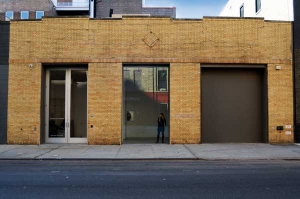
Christie’s International announced that they will be closing their Haunch of Venison subsidiaries in New York and London in March 2013. The gallery in Chelsea will close after its exhibition, How to Tell the Future from the Past, ends its run on March 2. The London gallery, known as the Yard, will be converted to a permanent exhibition and sales space for Christie’s private sales department.
Founded by art dealers Harry Blain and Graham Southern in 2002, Haunch of Venison represents and exhibits the works of emerging and established contemporary artists. The gallery’s name comes from the London courtyard, Haunch of Venison Yard, where it was originally based. Christie’s bought the gallery, which had branches in London, Berlin, and New York, in 2007. Haunch of Venison’s Berlin branch closed in 2010, the same year Blain and Southern left Haunch to start a new gallery, BlainSouthern.
Christie’s decision to shutter the Haunch of Venison galleries came as private sales have been gaining ground for the auction house. The restructuring will focus the company’s attention on those private sales rather than working as a primary gallery representing artists. Haunch of Venison has also withdrawn from the upcoming European Fine Art Fair in Maastricht.
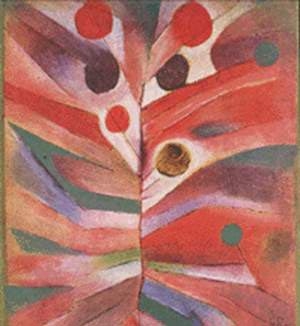
The heirs of Alfred Flechtheim, a prominent Jewish art dealer who fled Nazi Germany during World War II, are urging the German state of North-Rhine Westphalia to return artworks belonging to their relative. The paintings in question, which are by Paul Klee (1879-1940) and Juan Gris (1887-1927), are currently part of the Kunstsammlung Nordhein-Westfalen’s collection in Dusseldorf.
Before the perils of World War II took hold, Flechtheim was an established art dealer in Europe, representing a variety of well-known artists including Klee, Max Beckmann (1884-1950), and a number of French Cubists. Flechtheim ran galleries in Dusseldorf and Berlin, organized many exhibitions, and founded an art magazine. However, Flechtheim’s high standing in the art world made him an easy target for the Nazis. He fled Germany in 1933 shortly after a stream of hateful articles ran in the Nazi press. Flechtheim escaped to Zurich, then Paris before settling in London. After his getaway, Flechtheim’s Dusseldorf gallery was seized and turned over to his former employee Alex Voemel, a Nazi. Flechtheim’s gallery in Berlin was liquidated and his collection, which included works by Pierre-Auguste Renoir (1841-1919), Wassily Kandinsky (1866-1944), Fernand Leger (1881-1955), Georges Braque (1882-1963), and Henri Matisse (1869-1954), was sold.
Mike Hulton, Flechtheim’s great-nephew, claims that Klee’s Feather Plant (1919) and Gris’ Still Life (Violin and Inkwell) (1913) were part of Flechtheim’s private collection and sold under duress for well below their value when he fled Germany. The Kunstsammlung Nordhein-Westfalen does not believe there is enough evidence to support Hulton’s claim. In addition, owners of archives that could help in the case are refusing to let provenance researchers access their information, bringing the dispute to a standstill. Officials from the Kunstsammlung Nordhein-Westfalen assert that if it was proven that Flechtheim was forced to sell the works by Gris and Klee or that he received little to no money for them, that they would part with the paintings, but the current evidence is inconsequential.
Flechtheim’s heirs are currently pursuing restitution for over 100 paintings in museums in the United States, France, Germany, and other European countries.
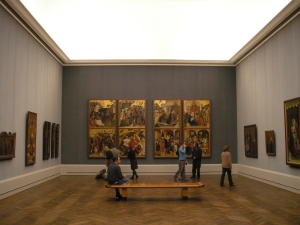
The fate of Berlin’s collection of Old Masters painting has been a source of controversy for nearly a year. While museum space in the city dwindles, the works are currently being held in the Gemäldegalerie, a museum devoted to European art from the 13th to 18th centuries, fueling concerns that the paintings may soon be banished to a storage facility.
German culture minister Bernd Neumann attempted to nix fears by reassuring the public that a new institution will be built to house the collection within five to six years. However, there is still some concern as to where the collection, which boasts masterworks by Rembrandt (1606-1669), Sandro Boticelli (1445-1510), Johannes Vermeer (1632-1675), and Peter Paul Rubens (1577-1640), will be exhibited until then.
Initial plans had the Old Masters collection going to the Bode Museum while the new Museum of 20th Century and Modern Art took over the Gemäldegalerie. However, Neumann has suggested a number of other options. One of the plans has the Old Masters remaining in the Gemäldegalerie and building an entirely new modern art museum. Another one of Neumann’s strategies has the Bode Museum swapping out its sculpture collection in exchange for the Old Masters paintings.
Neumann’s various plans will be proposed to the Prussian Foundation and a decision will be reached this spring.

Major Surrealist art collectors, Ulla and Heiner Pietzsch, are hoping to donate their impressive holdings to the city of Berlin. The only problem is there doesn’t seem to be room in any of the museums for the works. Worth nearly $200 million, the Pietzsch’s collection includes pieces by Salvador Dali (1904-1989), Max Ernst, (1891-1976) Rene Magritte (1898-1967), Yves Tanguy (1900-1955), and Joan Miro (1893-1983). The result of over fifty years of fervent collecting, the Pietzsch’s collection is currently hanging on the walls of their home in a suburb of Berlin.
The Pietzsches lent their collection to Berlin’s Neue Nationalgalerie for an exhibition in 2009. The show drew almost 200,000 visitors and proved that their holdings would be an asset to the city’s art offerings. Upon seeing the public’s high level of interest in their collection, the Pietzsches decided to donate the works to Berlin after their deaths; their only stipulation is that the works be kept on permanent display.
Earlier this year, officials suggested moving the Berlin’s Old Master paintings to make room for 20th century works but an online petition and spate of angry newspaper columns ensued. Authorities are currently working on plans to accommodate the gift.
One option currently being explored is the construction of an entirely new museum to house the Old Masters collection. If the city decides to do so, the Gemaeldegalerie at Potsdamer Platz would be freed up for 20th century art, including the Pietzsch’s collection. Currently, the only space in Berlin for 20th century art is at the Ludwig Mies van der Rohe-designed Neue Nationalgalerie. However, the space is too small to display all of Berlin’s holdings, much less the Pietzsch’s expansive collection.
Officials aim to release alternative plans to accommodate the Pietzsch gift during the first half of 2013.
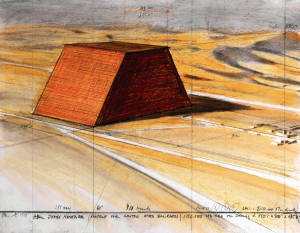
Bulgarian-born artist, Christo, is best known for his large-scale artworks that transform their environments. Working with his late wife, Jeanne-Claude, Christo draped Berlin’s parliament building, the Reichstag, in metallic-colored fabric (1995); completely wrapped Paris’ oldest bridge, the Pont Neuf, in 450,000-square-feet of golden material (1985); and surrounded 11 islands in Florida’s Biscayne Bay in pink fabric (1983).
The artist’s next endeavor is expected to be the world’s biggest permanent sculpture and will cost approximately $340 million, making it the most expensive as well. The structure, which will be built in the desert of Al Gharbia, 100 miles from Abu Dhabi, is a flat-topped pyramid that will stand 492 feet tall. The sculpture, titled The Mastaba, will be made out of 410,000 oil barrels painted in various colors inspired by the yellow and red sands of the desert, which will create the effect of an Islamic mosaic.
Christo and Jeanne-Claude conceived the idea for The Mastaba over 30 years ago, but were derailed by the Iran-Iraq war, among other things. Working with Sheikh Hamdan bin Zayed al-Nahyan, the representative of Abu Dhabi’s crown prince, Christo financed the project through sales of his own works and funds from various investors.
The Mastaba, which will take about 30 months to complete, will be Jean-Claude and Christo’s only permanent large-scale work.
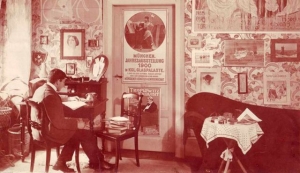
This past March, the highest court in Germany for civil affairs ordered that 4,300 pre-World War II posters looted by Nazis were to be returned to Peter Sachs, a retired airline pilot. Sachs is the son of Hans Sachs, a Jewish dentist who fled Germany in 1938 after being arrested by Nazis and sentenced to the Saschsenhausen concentration camp.
The poster collection, worth more than $5.8 million, was previously kept at The Deutsches Historisches Museum in Berlin. Sachs started his collection in the late 19th century at a young age and went on to publish a poster magazine called Das Plakat, found a society, and give lectures on the subject. Unique works by Henri de Toulouse-Lautrec, Ludwig Hohlwein, Lucian Bernhard, and Jules Cheret are included in the collection.
At the time of its confiscation, Sachs’ collection was the largest of its kind. When the Gestapo seized the posters in 1938, Sachs was told that Propaganda Minister Joseph Goebbels wanted the works for a new museum wing dedicated to “business” art. Sachs’ collection included advertisements for travel destinations and various products as well as propaganda and political posters.
When Sachs arrived in the U.S. with his wife and young son, he assumed that he would never see his collection again. In 1961 he accepted about $50,000 from the West German government, figuring the works had not survived the war. In 1966 when Sachs learned that some of his collection was still intact in East Berlin, he made contact with communist authorities in an attempt to get the posters loaned for exhibitions. He never succeeded.
After Sachs’ death, his son Peter fought a five-year legal battle for the return of his father’s posters after a government panel denied his claim in 2007. The court ultimately ruled that Sachs had never lost legal ownership of the post collection and that Peter, Sachs’ heir, had the right to possession.
Guernsey’s auction house will handle the collections’ sale in three intervals. The first auction is scheduled for January 18, 2013 and the second and third series will take place at six-month intervals. Guernsey’s hopes to find a single buyer for the collection and has been in talks with museums in Germany, Israel, and the U.S.

Last week at Sotheby’s auction house in London, Gerhard Richter’s Abstraktes Bild (809–4) sold to a telephone bidder for $34.2 million, the highest price paid for a living artist’s work at auction. Previously owned by musician and collector, Eric Clapton, the abstract painting was estimated to bring $14.1 million to $18.8 million.
Alex Branczik, Senior Director and Head of the Evening Auction of Contemporary Art, said, “The combination of outstanding provenance and gold-standard quality in this sublime work by this blue-chip artist made for an historic auction moment. Gerhard Richter’s international appeal as one of the hottest Contemporary artists was once again confirmed this evening.”
The German postwar painter, best known for his abstract and figurative works, was recently the subject of a critically acclaimed retrospective, Gerhard Richter: Panorama, at the Tate Modern in London, the Pompidou Center in Paris, and the Staatlichen Museum in Berlin. After the show, the prices of Richter’s works have continued to climb.
Friday’s sale beat out Jasper Johns’ Flag painting from the 1960s, which brought $28.6 million at Christie’s in 2010, for a living artist at auction. Richter, 80, lives in Cologne, Germany.
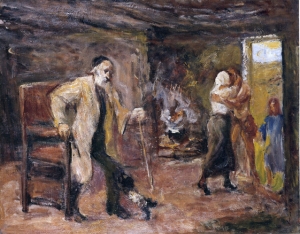
Berlin’s first Jewish Museum opened in January 1933, just one week before the Nazis seized power. Karl Schwarz, its founder, realized immediately that the museum was doomed and his life was in danger.
He fled Berlin for Tel Aviv months after opening the museum, which he’d worked for years to turn into a reality.
“The new museum had only just been founded and I had to leave it!” he wrote in his memoir. “But these considerations were hardly worth anything; much more important things were at stake -- my life, my work, my children’s future. I knew absolutely: There was nothing to hope for here.”
Almost 80 years and much painstaking research later, the Centrum Judaicum, on the site of the former museum, has reassembled some of the lost art for an exhibition titled “The Berlin Jewish Museum (1933-1938): Traces of a Lost Collection.”
Schwarz described his last tour of the museum in June 1933, the day before he left. “It seemed to me that the smell of Death already wafted through the halls,” he said.
Next to the New Synagogue on central Oranienburgerstrasse, the museum did survive for another five years, becoming an important refuge for Jewish artists, before being taken over and sealed by the Nazis in the pogroms of November 1938.
Its content, including paintings by Max Liebermann, Marc Chagall, Lesser Ury, Moritz Oppenheim and Leonid Pasternak, was seized and hidden: Some paintings were stashed in a vault on the other side of the city.
Lengthy Quest
The new show is the result of a 30-year quest by Hermann Simon, the director of the Centrum Judaicum, aided since about 1990 by his deputy Chana Schuetz.
Most of the recovered artworks are in Berlin on temporary loan for the exhibition, though the quest -- and the show --also paved the way for at least one restitution.
An examination of the back of a painting by Max Liebermann revealed that it never belonged to the Berlin Jewish Museum but was on loan from Liebermann’s widow, Martha. It will be returned by Jerusalem’s Israel Museum to the artist’s family after the show, the museum said in a statement yesterday.
The 1934 painting, one of Liebermann’s last, shows “The Return of Tobias,” a scene from the Book of Tobit. Liebermann intended it as a call to German Jews to return to Judaism in the face of Nazi persecution -- just as Tobias returned home to try to heal his father’s sight, Schuetz explained.
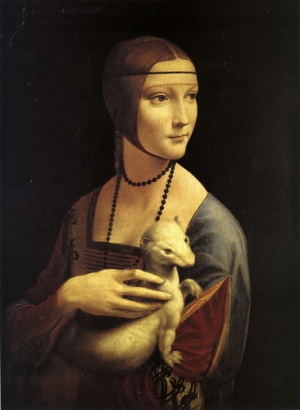
Even in illustrious company, Leonardo da Vinci’s “Lady With Ermine” radiates sheer class.
About 17, she has a pale oval face, a long aristocratic nose and a resolute mouth. She gazes intently over one shoulder while stroking the white creature in her arm with a fine-boned, pale hand. Her brown hair is neatly smoothed down and tucked back, giving her almost a 1920s appearance. She wears simple black beads and a richly colored gown with folds and gold brocade.
This 1490 portrait is the last visitors encounter in a magnificent exhibition called “Renaissance Faces” at Berlin’s Bode Museum. Curated in cooperation with the Metropolitan Museum of Art in New York, it comprises about 150 paintings, sculptures and medallions. The Louvre, the Uffizi and the National Gallery in London are among the many museums to loan works. The show moves to New York from Dec. 21 to March 18, 2012.
The combined clout of Berlin and New York allowed the curators to secure more prestigious loans than they could achieve individually. In the case of the ermine lady, the owner Adam Karol Czartoryski, a descendant of the Polish royal family, had to persuade a reluctant Polish government to let the painting travel (though it won’t go on to New York). It is usually housed in Krakow’s National Museum.
Organized as a tour of Italy, the exhibition introduces us to Botticelli’s blonde Florentine beauties and their rich banker lovers, old men from Ferrara delicately portrayed in Pisanello drawings, the dukes of Milan, Mantua and Naples, angelic young boys from Rome and solemn doges of Venice.
Renaissance Blondes
Portraits of the 15th century had to flatter, yet they also had to bear some likeness to the subject. Ladies seemed more willing to sacrifice identity for beauty -- it is hard to imagine that there were so many blonde, blue-eyed women in Renaissance Italy, especially when most of the men were dark.
Still, Leonardo’s ermine lady, Cecilia Gallerani, complained a few years after the portrait was completed that it didn’t resemble her anymore because it showed her in her youth, and therefore not yet complete.
Men were permitted flaws. In Domenico Ghirlandaio’s touching 1490 portrait of an old man with his grandson, a painting that normally hangs in the Louvre, the old man in question has a bulbous, warty nose.
The wealthy, powerful, Florentine banker Niccolo Strozzi was, according to contemporary documents, a lover of fine food. A 1446 letter describes him as “so blubbery he cannot move.” Mino da Fiesole’s marvelous marble sculpture is kinder, showing him with a strong face and paunchy jowls. The mountain of fat is hidden under folds of voluptuous fabric.
|
|
|
|
|